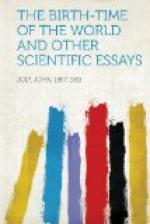70
increasing consumption of inanimate power by civilised races, we see revealed the dynamic attitude of the organism working through thought-processes.
Whether this be so or not, we find generally in organised nature causes at work which in some way lead to a progressive transfer of energy into the organic system. And we notice, too, that all is not spent, but both immediately in the growth of the individual, and ultimately in the multiplication of the species, there are actions associated with vitality which retard the dissipation of energy. We proceed to state the dynamical principles involved in these manifestations, which appear characteristic of the organism, as follows:—
The transfer of energy into any animate material system is attended by effects conducive to the transfer, and retardative of dissipation.
This statement is, I think, perfectly general. It has been in part advanced before, but from the organic more than the physical point of view. Thus, “hunger is an essential characteristic of living matter”; and again, “hunger is a dominant characteristic of living matter,"[1] are, in part, expressions of the statement. If it be objected against the generality of the statement, that there are periods in the life of individuals when stagnation and decay make their appearance, we may answer, that
[1] Evolution of Sex. Geddes and Thomson, chap. xvi. See also a reference to Cope’s theory of “Growth Force,” in Wallace’s Darwinism, p. 425.
71
such phenomena arise in phases of life developed under conditions of external constraint, as will be urged more fully further on, and that in fact the special conditions of old age do not and cannot express the true law and tendency of the dynamic relations of life in the face of its evident advance upon the Earth. The law of the unconstrained cell is growth on an ever increasing scale; and although we assume the organic configuration, whether somatic or reproductive, to be essentially unstable, so that continual inflow of energy is required merely to keep it in existence, this does not vitiate the fact that, when free of all external constraint, growth gains on waste. Indeed, even in the case of old age, the statement remains essentially true, for the phenomena then displayed point to a breakdown of the functioning power of the cell, an approximation to configurations incapable of assimilation. It is not as if life showed in these phenomena that its conditions could obtain in the midst of abundance, and yet its law be suspended; but as if they represented a degradation of the very conditions of life, a break up, under the laws of the inanimate, of the animate contrivance; so that energy is no longer available to it, or the primary condition, “the transfer of energy into the animate system,” is imperfectly obeyed. It is to the perfect contrivance of life our statement refers.
That the final end of all will be general non-availability there seems little reason to doubt, and the organism, itself dependent upon differences of potential, cannot




